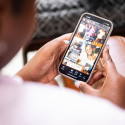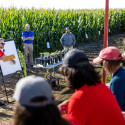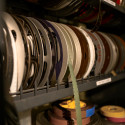Geologist, grad student traveled to China ÷ despite SARS scare
John Valley scans through digital photos of a trip to China he took earlier this year. It’s hard to tell if Valley or his traveling companion smiled for the camera, because every snapshot shows them wearing surgical face masks.
Valley, a geologist, and Aaron Cavosie, a graduate student in Valley’s lab, traveled to Beijing in mid-April, just as the city began to emerge as the hardest hit with reported cases of sudden acute respiratory syndrome, or SARS.
The trip had been on the scientists’ calendars for more than six months. If the geologists didn’t leave as scheduled, they would lose precious research time on one of the world’s few ion microprobes — sophisticated instruments that can determine the age and the chemical composition of earthly and extra-terrestrial minerals.
For instance, Valley and his colleagues used this type of instrument to analyze the tiny grain of zircon, a mineral commonly studied by geologists. The analysis led to the discovery of the world’s oldest known sample (4.4 billion years old), which, in turn, provided some of the first evidence that the early Earth was cool enough to have water, continents and conditions needed to support life.
But geologists getting time on ion microprobes, says Valley, is just as difficult as astronomers getting time on telescopes. “There are only a few of these instruments in North America,” he says, “and they’re booked up all the time.”
After using the instrument at the Beijing lab last summer to date the world’s second oldest zircon, Valley and his colleagues were invited back for an 11-day period. “That’s 264 shift hours — a five-year allotment of time on these North American microprobes,” says Valley. “That’s gold!”
The Wisconsin geologist points out that without this time on the ion microprobe, Cavosie would not be able to collect data for his dissertation, possibly setting back his career.
Cavosie headed to Beijing on April 17, and Valley left two days later. Although the World Health Organization reported 3,547 probable cases of and 182 deaths from SARS worldwide at this time, Beijing officials had reported fewer than 40 probable cases. (The Chinese government soon admitted it had underreported.)
“By the time we left, we knew all about SARS,” says Valley. “It was a risk, but not a terribly unreasonable one.”
When they arrived in China, the UW–Madison scientists played it safe.
“We took unbelievable precautions,” says Valley. They wore face masks everywhere, except in the lab and hotel room; they took their temperatures to check for fever (a SARS symptom) twice daily; they used pens to push elevator buttons; and, according to Valley, they washed their hands “nearly 100 times a day.”
All their news sources, including the Centers for Disease Control and the WHO, reported about 100 new SARS cases in Beijing each day. This linear growth rate kept the geologists calm.
“If the rate of growth had become exponential,” explains Valley, “we would have left right away.”
Worried that the Chinese government would restrict foreigners from leaving Beijing, as it had recently done to the country’s citizens living in the city, Valley and Cavosie cut their trip short by one day. April 29, when they departed, the WHO reported 1,347 probable cases of SARS and 59 related deaths in Beijing, compared to 5,462 cases and 353 deaths worldwide.
After passing through medical checkpoints at the Beijing airport and spending hours on an airplane flying a concentration of potential SARS carriers, Valley and Cavosie arrived back in Madison free of the respiratory syndrome. Yet, Valley attended only the activities he needed to, such as teaching a class of eight students.
In early May, the Beijing lab, like its nearby restaurants, shut down; it didn’t re-open until mid-June. “There’s now a huge backlog of people who want to use the lab,” says Valley.
Valley’s future trips into health advisory zones may become unnecessary: UW–Madison just received $2 million from the National Science Foundation to purchase its own ion microprobe. More than 40 researchers from 11 departments were involved in the proposal. Valley expects it will take at least three years to order, build and install the instrument, along with its seven-ton magnet, in the basement of Weeks Hall.
Tags: research




